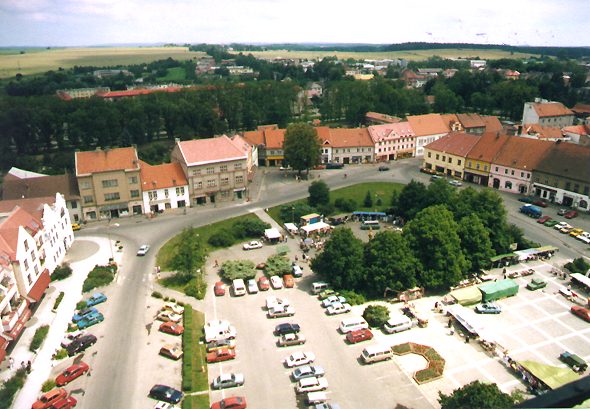Our Historic Torah Scroll
Our Torah scroll was written sometime in the 1700s and resided in a small town in Czechoslovakia called Sobeslav (Sobislau). The town's synagogue was built in the 1880s, so presumably the scroll was housed in a private residence for community use before the synagogue was built.
"modified Beit Yosef"
This Torah scroll uses a special script called "modified Beit Yosef." This scroll is particularly uncommon, in that it is written on approximately 50 deerskins (bellies). By Jewish law, an animal may not be killed only to be used for leather, but must also be used for food. Deer are kosher animals, but hard to shecht (kill in a ritually kosher way). We therefore speculate that the deer were neither killed nor eaten by the Jews; however their hides were purchased for the Torah scroll.
Scrolls of Sobeslav
Nearly the entire Jewish population of Sobeslav perished in concentration camps during the Shoah. The Nazis meanwhile stripped synagogues of articles of value and sent many of them to be warehoused. Many of these objects are now in the State Jewish Museum in Prague.
For 20 years after the war, these stolen items, including 1,564 Torah Scrolls from throughout Bohemia, Moravia, and Slovakia, lay piled in the disused Michle Synagogue outside Prague. In 1964 these sacred Scrolls were given to the care of the Westminster Synagogue in London. Then came the monstrous task of cataloguing, inspecting and classifying the scrolls according to their condition. Those that were deemed usable, or could be made usable without too much labor, were put up for distribution to various Jewish agencies. Priority was given to synagogues that did not have a Torah scroll of their own. These special Scrolls are now in use in many countries around the world.
Requesting a torah scroll
Some of the collection remain at Westminster Synagogue, a permanent memorial to the martyrs from whose synagogues they come. The rest have been distributed throughout the world, to synagogues as well as to Yad Vashem, Westminster Abbey, and the Royal Library at Windsor Castle. These scrolls serve, in the words of Harold Reinhart, "to live, to commemorate, to inspire a saddened but not hopeless world, and to glorify the holy Name."
When a request for a Torah is approved by the committee, a scroll is handed over on a "permanent loan" basis. Our scroll (catalogued as No. 1144) came to us by way of Etz Chaim, a now disbanded congregation in Novato. They had made the request, which was approved, and had already received the Torah when the congregation disbanded. When some of the members of Etz Chaim joined our community, they told us about the Scroll and made the arrangements for the transfer. That's how we came to be the proud guardians of one of the Czech Memorial scrolls.
Sobeslav today has no Jewish population. The synagogue, after years as a warehouse, has been restored as a workshop and apartments. The only known Jewish survivor of Sobeslav was its rabbi, Dr. Arthur Katz, who happened to be out of the country at the time of the deportation. Dr. Katz went on to become the first rabbi of Hendon Reform Synagogue outside of London. Dr. Katz's son, Steven, is today the rabbi at that same synagogue. In 2009, Hendon Reform Synagogue became the keepers of another of the 13 surviving Torah scrolls from Sobeslav.
To find out more about important work of the Memorial Scrolls Trust, click here.
Names of the Jews of Sobeslav who perished in the Shoah, inscribed on the interior walls of the Pinkas Synagogue in Prague. Photo by Barbara Lesch McCaffry.
Sobeslav's central square today.
Photo by Martin Bilek.
Members of Hendon Reform Synagogue
welcome their Sobeslav Torah scroll in 2009.







